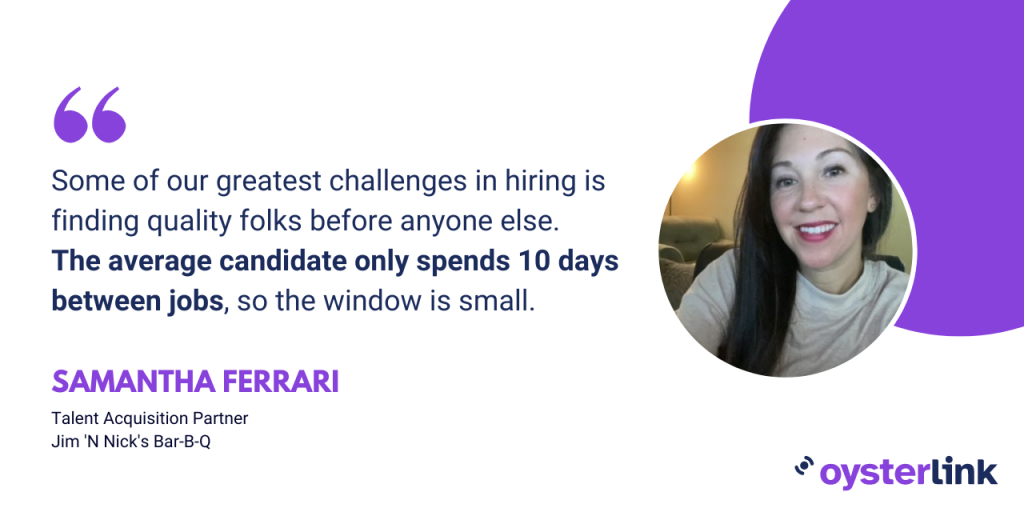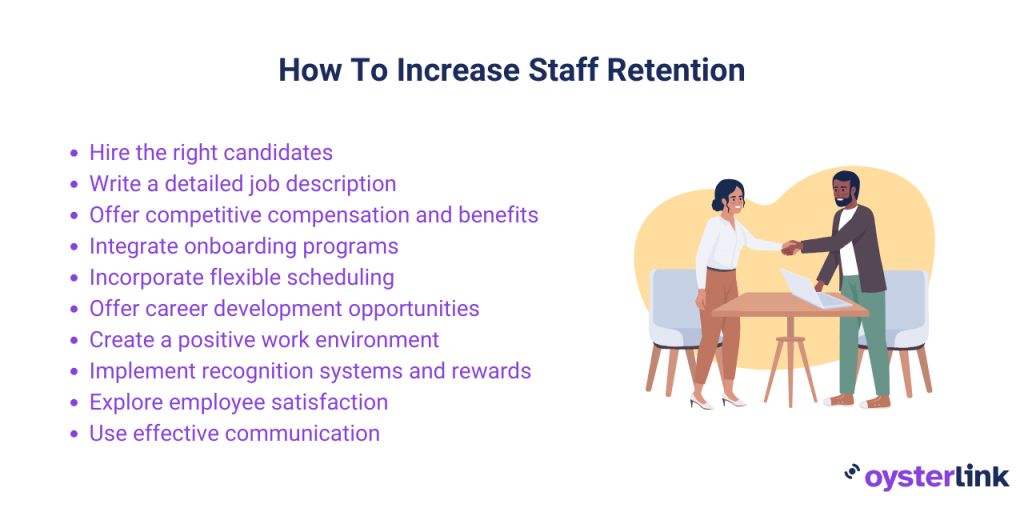Reducing employee turnover is a key concern for all businesses, since a high turnover rate can cost a company up to twice the employee’s annual salary.
With an annual turnover rate of 70–80%, this is especially true in the hospitality industry.
To solve the issue of high turnover rate, restaurants and hotels need to identify and implement effective staff turnover solutions.
In this article, we’ll cover how to calculate staff turnover, what causes it and the most important part — how to reduce employee turnover.
For a more comprehensive perspective, we spoke to Samantha Ferrari, a talent acquisition partner at Jim ‘N Nick’s Bar-B-Q, who brings a wealth of expertise to our discussion.
What Is Employee Turnover?
Staff turnover is the rate at which employees leave or quit work and are replaced by new hires. In a business context, it’s an important metric used to assess the stability and consistency of the workforce.
High turnover can indicate problems within the organization, such as dissatisfaction with working conditions, inadequate compensation or poor management.
On the other hand, low turnover often suggests a healthy work environment with satisfied and engaged employees.
Good vs. Bad Staff Turnover Rate
When talking about average numbers in most industries, a good employee turnover rate typically falls below 10%, indicative of a stable and content workforce.
In contrast, a turnover rate above 18% is considered bad and often signals issues within the organization. However, it’s worth noting that some industries experience higher turnover rates, such as the hospitality and restaurant industries.
How to Calculate Staff Turnover
To calculate staff turnover, divide the number of employees who have left the company by the average number of total employees over a certain period (often a year). Then, multiply the result by 100 to get the final employee turnover rate.

Top 10 Strategies to Reduce Staff Turnover in the Hospitality Industry
Staff retention strategies in the hospitality industry are crucial for maintaining a dedicated and proficient workforce, ultimately contributing to the overall success of your business.
Here are a few tips you can follow to reduce employee turnover:
1. Hire the Right Candidates
Hiring and interviewing the right candidates involves not only assessing their skills and experience but also ensuring they’re a good fit with the company culture.
For example, a hotel known for its exceptional customer service might prioritize candidates who demonstrate strong interpersonal skills and a genuine passion for hospitality. This alignment between the employee’s values and the company’s standards can lead to longer tenure.

2. Write a Detailed Job Description
A clear and comprehensive job description ensures that potential candidates have a realistic understanding of the role.
A comprehensive job description typically includes details such as:
- Job title
- Location of the job
- Overview of the role
- Key responsibilities
- Operational tasks
- Required experience and qualifications
- Availability requirements
- Technical skills and proficiencies
- Salary range and benefits
- Application process
- Equal opportunity statement
This reduces the likelihood of hiring someone who isn’t the right fit, which can lead to early turnover.
For example, if a hotel is seeking a front desk manager, a detailed job description should include not just the operational tasks, but also expectations regarding guest interaction, problem-solving skills and team management.
3. Offer Competitive Compensation & Benefits
Offering competitive compensation is a key strategy to reduce employee turnover.
This approach goes beyond just your paycheck — it includes benefits like:
- Health insurance
- Retirement plans
- Performance bonuses
- Paid time off
- Maternity & paternity leave
- Employee wellness programs
- Flexible working arrangements
For instance, a company might offer above-industry-average salaries, yearly bonuses based on performance and comprehensive health benefits. They could also offer maternity/paternity leaves and a generous PTO policy, which includes vacation, sick days and personal time. This not only attracts high-quality candidates but also gives a sense of value and appreciation in employees, encouraging them to stay longer with the organization.
4. Integrate Onboarding Programs
Integrating targeted training programs during the onboarding process is essential, particularly for new employees with limited or no experience in their hired role. Onboarding training serves as the foundation for a new employee’s career development, equipping them with the necessary skills and knowledge to succeed in their position.
For example, a company might organize hands-on sessions to familiarize new employees with booking and management systems that are crucial for daily operations..
5. Incorporate Flexible Scheduling
Flexible scheduling is a strategy to reduce employee turnover by accommodating the varying personal needs and lifestyles of employees. This can include options like flexible start and end times, compressed workweeks or the ability to swap shifts.
For example, a hotel might allow a parent employee to start their shift after school drop-off times. Such flexibility can significantly enhance job satisfaction and work-life balance, making employees more likely to remain with the organization.

6. Offer Career Development Opportunities
Career development as a strategy for reducing employee turnover involves providing clear pathways for professional growth and advancement within the organization. According to a research, 94% of employees indicated their likelihood to stay longer at a company that invests in their learning and development.
For example, a hotel may offer in-house training programs, mentorship opportunities or support for further education in hospitality management. This not only enhances employees’ skill sets but also demonstrates the organization’s commitment to their career progression.
7. Create a Positive Work Environment
Creating a positive work environment involves cultivating a respectful, inclusive and supportive workplace where employees feel valued and heard.
For example, creating a positive work environment includes implementing a clear code of conduct that outlines acceptable and unacceptable behaviors within the workplace is crucial. Regular training sessions on this code can help prevent workplace harassment and bullying. These trainings should cover topics such as respect in the workplace, recognizing and reporting harassment and the consequences of violating the code of conduct.
8. Implement Recognition Systems and Rewards
Implementing a system of recognition and rewards is a powerful way to reduce employee turnover.
For example, a restaurant could introduce an “Employee of the Month” program, offering not just a title, but tangible rewards like a bonus, extra day off, or public acknowledgment. Such programs show employees that their hard work and dedication are noticed and valued.
9. Explore Employee Satisfaction
This might sound like a no-brainer, but a strong correlation exists between lower employee turnover and higher employee satisfaction. This connection underscores the importance of fostering a positive work environment where employees feel valued and engaged.
For example, conducting regular surveys to gauge employee satisfaction and acting on the feedback can lead to a more contented workforce. Also, implementing one-on-one meetings between employees and HR representatives can be a valuable strategy as well. These meetings provide a private and safe space for employees to discuss their experiences, career goals, concerns or any workplace issues they might be facing.

10. Use Effective Communication
Effective communication involves creating clear, open channels for feedback and dialogue between management and staff.
For example, a company might hold regular town hall meetings where employees can voice concerns and suggestions. This approach ensures that employees feel heard and valued, leading to increased job satisfaction and loyalty.
Another example could be when supervisors personally acknowledge and commend their team members for their achievements. Recognizing a job well done, whether through a simple thank-you note or a simple mention in a team meeting can significantly boost morale and motivation.

5 Common Reasons for High Employee Turnover Rates
Recognizing issues that cause high employee turnover rates is the first step in creating a more stable, satisfied and productive workforce.
The most common employee turnover reasons are:
1. Work-Life Balance Challenges
The nature of hospitality jobs often requires long, irregular hours, including nights, weekends and holidays. This can lead to burnout and dissatisfaction, as employees struggle to balance work with personal life.
For example, a staff member working consecutive night shifts and weekends could miss family events or have a tough time finding room for personal time, which is vital for hobbies, rest and relaxation.
2. Limited Career Advancement Opportunities
Approximately 20% of employees would prefer a job promotion over a salary increase.
Employee longevity in hospitality jobs may be affected by feeling undervalued or unchallenged in their current roles, leading to a decrease in motivation and engagement. This lack of progression can also diminish their sense of loyalty to the organization, as they may feel that their career goals cannot be achieved within the current workplace.
For example, a Restaurant Server who has been in the same position for several years without any promotion or professional growth prospects might find a senior position in another restaurant.
3. Stressful Work Environment
High-pressure situations, demanding customers and fast-paced work can contribute to a stressful environment. These factors, often beyond the direct control of an employer, significantly contribute to a stressful work atmosphere. It’s important to acknowledge that while the nature of the industry naturally involves these stressors, their impact can be exacerbated by insufficient support from management.
For instance, when staff members are not adequately supported by their managers or the organization, the normal stressors of the job can become overwhelming. This lack of support might manifest as inadequate staffing, limited resources, lack of recognition, or insufficient training to handle challenging situations effectively.
4. Lack of Recognition & Reward
Approximately 36% of employees reported leaving their job due to a lack of recognition in the workplace.
When employees feel their hard work and dedication are not acknowledged or rewarded, their motivation and job satisfaction can decline, increasing the likelihood of seeking employment elsewhere.
For example, a Chef or a Sous Chef who consistently receives praise from customers but is never formally recognized or rewarded by the management could start thinking about quitting their job.
5. Poor Management
Poor management can cause a range of issues, from ineffective communication and lack of support to inadequate leadership and poor decision-making. Employees often leave due to feeling undervalued or misunderstood by management, experiencing a lack of guidance or facing unrealistic expectations.
A Restaurant General Manager who rarely communicates with the staff, offers little guidance and sets unrealistic targets will lead to confusion and dissatisfaction among employees.
The Impact of High Employee Turnover Rates
High turnover rates in the hospitality industry can have several profound impacts such as:
- Financial costs: Businesses incur significant expenses in recruiting, hiring and training new employees. Frequent turnovers increase these costs.
- Operational efficiency: Constantly replacing staff disrupts operations, as new employees need time to learn and adapt. This can reduce overall productivity and efficiency.
- Customer experience: A constantly changing workforce can affect service quality. Experienced staff are crucial for maintaining high standards in customer service and their loss can lead to a decline in guest satisfaction.
- Employee morale: High turnover can demoralize remaining employees, as they may feel overburdened with additional responsibilities or face challenges in adapting to new team dynamics.
- Knowledge and skills loss: When employees leave, they take their knowledge and skills with them, which can be a significant loss, especially if they had key positions.
- Company reputation: Frequent staff changes can negatively affect a company’s reputation, both as an employer and in terms of service quality, potentially impacting customer loyalty and future recruitment.
Reduce Employee Turnover With OysterLink’s Tips
Navigating the complexities of reducing employee turnover is just one aspect of running a business in the hospitality industry. At OysterLink, we focus on equipping you with the tools to not only excel individually but to also master the art of retaining a dedicated workforce.
Our Spotlight section offers in-depth resources tailored to minimize staff turnover, including:
- Current salary trends to ensure competitive compensation
- Detailed job descriptions for precise candidate fit
- Effective interview strategies
- Insightful analyses of hospitality industry trends
Our platform connects you with top employers and provides valuable insights for career growth.
Join OysterLink to access these valuable resources and transform your team’s stability and satisfaction. Stay informed and proactive in shaping a thriving workplace.




